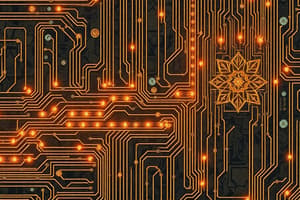Podcast
Questions and Answers
What is referred to as the state reduction problem in sequential circuits?
What is referred to as the state reduction problem in sequential circuits?
- The assignment of unique binary values to each state.
- The reduction in the number of flip-flops while maintaining output requirements. (correct)
- The increasing of flip-flops to enhance circuit functionality.
- The elimination of all states from a state table.
When are two states considered equivalent in a sequential circuit?
When are two states considered equivalent in a sequential circuit?
- They must have different binary assignments.
- They utilize separate flip-flops.
- They lead to different output states.
- They produce identical outputs for a specific set of inputs. (correct)
What is the purpose of assigning binary values to states in sequential circuit design?
What is the purpose of assigning binary values to states in sequential circuit design?
- To reduce the number of flip-flops in the circuit.
- To streamline the logic design by minimizing gates needed.
- To ensure that circuits can be manually designed without automation.
- To assign unique codes that correlate to each state. (correct)
Which component is primarily used as the building block by synthesis tools in sequential circuit design?
Which component is primarily used as the building block by synthesis tools in sequential circuit design?
Which statement about don't-care conditions is true during circuit design?
Which statement about don't-care conditions is true during circuit design?
What is the first step in the design of synchronous sequential circuits?
What is the first step in the design of synchronous sequential circuits?
What is the significance of having at least $2^n \geq m$ in state assignment?
What is the significance of having at least $2^n \geq m$ in state assignment?
Which of the following is NOT included in the design procedure for synchronous sequential circuits?
Which of the following is NOT included in the design procedure for synchronous sequential circuits?
Flashcards
State Reduction
State Reduction
The process of minimizing the number of states in a state table without changing its input-output behavior.
Equivalent States
Equivalent States
Two states are considered equivalent if they produce the same output for every possible input and transition to either the same state or another equivalent state.
State Assignment
State Assignment
The process of assigning unique binary codes to each state in a sequential circuit.
Number of Bits for State Assignment
Number of Bits for State Assignment
Signup and view all the flashcards
D Flip-flop Based Design
D Flip-flop Based Design
Signup and view all the flashcards
Sequential Circuit Design Procedure
Sequential Circuit Design Procedure
Signup and view all the flashcards
State Diagram
State Diagram
Signup and view all the flashcards
Logic Diagram
Logic Diagram
Signup and view all the flashcards
Study Notes
Sequential Logic Circuits
- Sequential logic circuits' state is dependent on previous inputs
- State reduction reduces the number of flip-flops in a sequential circuit
- State-reduction algorithms aim to reduce the number of states in a state table without changing external input-output requirements
- Equivalent states provide the same output and transition to the same or an equivalent state for each input
- Removing one equivalent state doesn't alter input-output relationships
- Designing sequential circuits involves assigning unique binary codes to states.
- "m" states require "n" bits, where 2n ≥ m
- Unused states act as don't-care conditions during design
- Don't-care conditions often lead to simpler circuits
- Automated synthesis tools, using D flip-flops, build complex circuits
Design Procedure
- Design methodologies define hardware to implement desired behavior
- Small circuits are sometimes designed manually, but large circuits rely on automated synthesis tools
- Synthesis tools primarily use D flip-flops to implement circuit behavior; these, together with additional logic, can represent JK and T flip-flops
Procedures for Designing Synchronous Sequential Circuits
-
A state diagram describes the circuit's operation, based on the specifications
-
The number of states may be reduced, if necessary
-
Binary values are assigned to each state
-
A binary-coded state table is created
-
The type of flip-flops (e.g., D, JK, T) is selected
-
Simplified input equations for flip-flops and output equations are developed
-
A logic diagram is drawn
Example: Detection of Sequences of Three or More Consecutive 1's
- A circuit detects three or more consecutive 1's from a serial input line.
- Techniques include use of D flip-flops and JK flip-flops.
Example: 3-Bit Binary Counter
- A 3-bit binary counter uses T flip-flops.
Studying That Suits You
Use AI to generate personalized quizzes and flashcards to suit your learning preferences.




